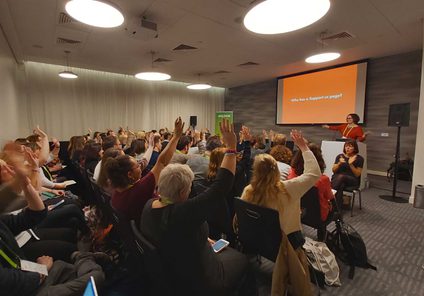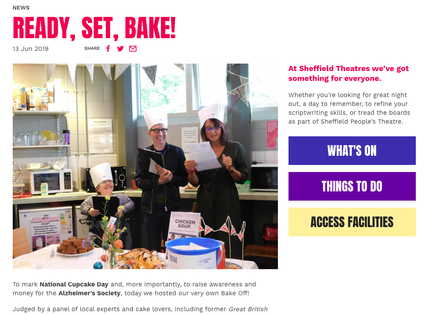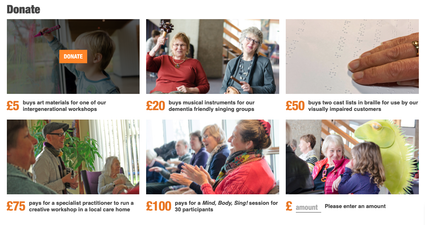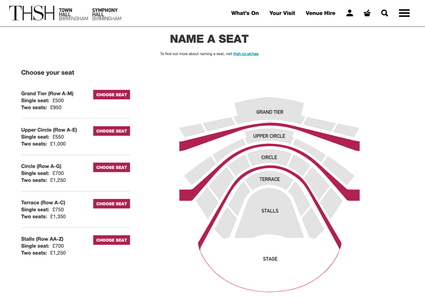Creating successful online fundraising campaigns
Earlier in the year I wrote about the Support Us page and how useful it is online. With very few page views and very low conversion rates, it’s difficult to justify its existence.
Last week I presented at the annual Spektrix Conference. My session followed up from my blog earlier in the year. The whole room said they had a typical Support Us page… but hands didn’t stay up when asked if they’d updated it recently!

We often see teams spend a lot of time crafting the Support Us page, only to leave it untouched for a long time. The case for support often isn’t very interesting, the content doesn’t change and donors need to be highly motivated to make a gift. It’s no wonder it’s not often visited!
Rather than rely on the Support Us page, we’re seeing organisations use smart tools, creativity, imagination and storytelling to achieve great fundraising results online.
The recipe for a good campaign
You can be as creative and imaginative as you like when it comes to fundraising. But the truth is, very few people will come to it online without a marketing strategy behind it (which is why you should work closely with your marketing colleagues!).
We’ve seen organisations do great things with just four simple ingredients:
- A good story: There’s a reason we get distracted by nice stories online… information isn’t enough for us, we want a story with a happy ending!
- Smart digital tools: The more tools you have at your disposal, the easier it is to create short term campaigns, as well as long standing campaigns (like Name a Seat campaigns).
- Lots of channels: you need to share the stories through social media, email, print, word of mouth etc
- Imagination and creativity!
Here are three case studies from organisations we’re working with. It’s worth noting that each uses Spektrix CRM for ticketing and fundraising.
Sheffield Theatres
Sheffield Theatres is a producing and receiving company based in Sheffield. Consisting of the Lyceum, Crucible and Studio theatres.
At Sheffield Theatres, the marketing and fundraising teams work closely together. This makes for some smart decisions when it comes to online fundraising!
Ready, Set, Bake
In June the team ran a bake-off competition for National Cupcake Day. They used the occasion to raise awareness for Alzheimer's UK and their own Dementia Friendly work.
This is a great example of using storytelling and adding a bit of fun to fundraising. They published a news article on the website and had a donation ask at the bottom.


The donation ask at the bottom uses Spetkrix’s web component. But rather than needing a developer to add this to a page, we’ve baked (!) it into the CMS. This means the team at Sheffield Theatres can add it to any page, with any value, as a single button or a series of values.
Here’s Sheffield Theatres’ recipe for this campaign:
- Shared the article on social media channels
- Emailed prospects about the event and the case for support
- Clear case for support
- Simple donation ask
And the success…
- £184 in donations on the day
- 249 page views on the new item
- 42% Email open rate
- 93 email recipients went on to donate within two weeks of receiving the email
- Lots of cake!
Chichester Festival Theatre (CFT)
CFT is a producing theatre with two venues - Minerva and the Festival Theatre.
Over the past two years, CFT have taken part in Giving Tuesday. A nationwide campaign is a great way to get your message heard across lots of channels without having to drum up the buzz all on your own.
For the campaign, we used Spektrix’s web component again, but this time built CFT a custom page. Using images and copy provided by the team at CFT, we built a clear ask with various amounts.

CFT ran the same campaign in 2017 and 2018. The main difference in the online campaign is the use of images and tangible benefits.
CFT’s recipe:
- Joined a movement
- Shared the campaign on social channels
- Email sent to prospects
- Clear case for support
- Added images to donation asks
- Added tangible benefits
And the results:
- 430 page views in the months following the campaign
- 59% higher average donation value than the previous year
- 64% more income raised
This is a great example of where adding photos and compelling copy to a donation ask can have a significant impact!
Town Hall Symphony Hall (THSH)
THSH is two concert halls in Birmingham with a varied programme including classical, rock, pop, comedy and spoken word.
Like many venues, they offer donors the opportunity to name a seat in the hall. And like many, they had struggled to offer this option online.
Earlier in the year we built a Name a Seat campaign that uses Spektrix’s API to process the donation and post the donors seat number and dedication back to Spektrix.

This was a substantial piece of work, and not something we’d recommend for a short or one off campaign. But for something like a Name a Seat campaign, or a membership scheme, it’s worth investing in digital tools that remove barriers. Whenever possible, we need to avoid donors having to fill in and send back forms!
But of course, just having this on THSH’s website, won’t do much. So how have they promoted the campaign:
- Invested in video content
- Shared the campaign on social channels
- Email campaign
- Held a raffle
And the results:
- 293 page views on /support/name-a-seat
- 785 page views of Name a Seat
- 55% open rate and 3% click-through rate on email
- £465 raised with raffle
- 2 seats named (total value of £1,000)!
Key takeaways
There’s a lot of value in the general support page. It lets people know you’re a charity, and if someone wants to donate, they can do (never underestimate this!). But, it’s not going to achieve your goals of engaging more donors and raising more money on its own.
The three examples above show how you can use your website and online tools to generate income.
It’s worth noting that all three of the organisations featured have the means to add a donation ask to any page, and CFT are about to revamp their very own online Name a Seat campaign.
So here are my top tips for running online fundraising campaigns:
- Tell stories
- You can build it, but they won’t come!
- Invest in flexible tools
- Experiment
- Use imagination and fun!